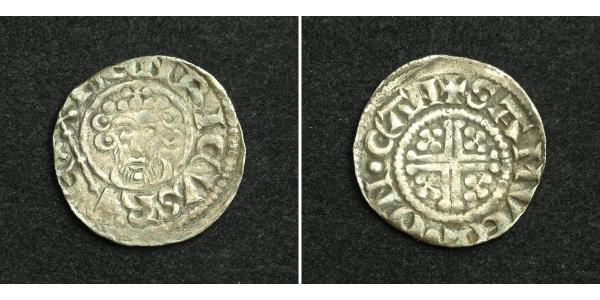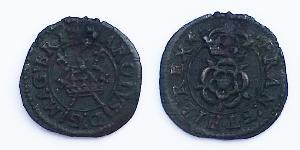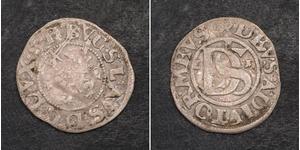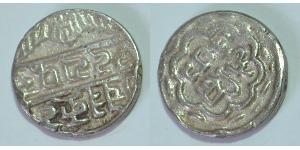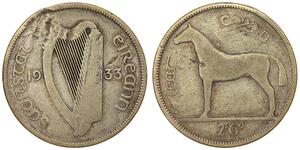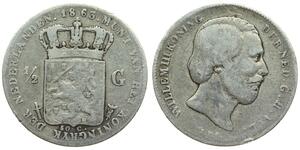(售价 $104.0)
1207, England, Plantagenets, King John. Scarce Silver Short-Cross Penny Coin. R!
Condition: VF+
Moneyer: Samuel
Mint Place: Canterbury
Mint Period: 1199-1216 AD
Reference: Class 5c, S.1352. RR!
Denomination: Short-Cross Penny
Diameter: 18.5mm
Material: Silver
Weight: 1.44gm
Obverse: Facing bust of King John of England inner circle. Hand with cross-topped scepter to right splitting legend.
Legend: hENRICVS R EX
Reverse: Short-cross with four x-shpaed crosses within inner circle. Moneyer and mint name in legend around.
Legend: CANTERBURY - SAMUEL.
John (24 December 1166 – 18/19 October 1216), also known as John Lackland or Softsword, was King of England from 6 April 1199 until his death. During John's reign, England lost the duchy of Normandy to the French king Philip II, which resulted in the collapse of most of the Angevin Empire and contributed to the subsequent growth in power of the Capetian dynasty during the 13th century. The baronial revolt at the end of John's reign led to the signing of the Magna Carta, a document often considered to be an early step in the evolution of the constitution of the United Kingdom.
John, the youngest of five sons of King Henry II of England and Eleanor, Duchess of Aquitaine, was at first not expected to inherit significant lands. Following the failed rebellion of his elder brothers between 1173 and 1174, however, John became Henry's favourite child. He was appointed the Lord of Ireland in 1177 and given lands in England and on the continent. John's elder brothers William, Henry and Geoffrey died young; by the time Richard I became king in 1189, John was a potential heir to the throne. John unsuccessfully attempted a rebellion against Richard's royal administrators whilst his brother was participating in the Third Crusade. Despite this, after Richard died in 1199, John was proclaimed king of England, and came to an agreement with Philip II of France to recognise John's possession of the continental Angevin lands at the peace treaty of Le Goulet in 1200.
When war with France broke out again in 1202, John achieved early victories, but shortages of military resources and his treatment of Norman, Breton and Anjou nobles resulted in the collapse of his empire in northern France in 1204. John spent much of the next decade attempting to regain these lands, raising huge revenues, reforming his armed forces and rebuilding continental alliances. John's judicial reforms had a lasting, positive impact on the English common law system, as well as providing an additional source of revenue. An argument with Pope Innocent III led to John's excommunication in 1209, a dispute finally settled by the king in 1213. John's attempt to defeat Philip in 1214 failed due to the French victory over John's allies at the battle of Bouvines. When he returned to England, John faced a rebellion by many of his barons, who were unhappy with his fiscal policies and his treatment of many of England's most powerful nobles. Although both John and the barons agreed to the Magna Carta peace treaty in 1215, neither side complied with its conditions. Civil war broke out shortly afterwards, with the barons aided by Louis of France. It soon descended into a stalemate. John died of dysentery contracted whilst on campaign in eastern England during late 1216; supporters of his son Henry III went on to achieve victory over Louis and the rebel barons the following year.
Contemporary chroniclers were mostly critical of John's performance as king, and his reign has since been the subject of significant debate and periodic revision by historians from the 16th century onwards. Historian Jim Bradbury has summarised the contemporary historical opinion of John's positive qualities, observing that John is today usually considered a "hard-working administrator, an able man, an able general". Nonetheless, modern historians agree that he also had many faults as king, including what historian Ralph Turner describes as "distasteful, even dangerous personality traits", such as pettiness, spitefulness and cruelty. These negative qualities provided extensive material for fiction writers in the Victorian era, and John remains a recurring character within Western popular culture, primarily as a villain in films and stories depicting the Robin Hood legends.
1/2 Crown 爱尔兰共和国
本组有 44 钱币 / 43 售价
⇑
50 Cent / 1/2 Gulden 荷兰王国 銀 威廉三世 (尼德兰)
本组有 13 钱币 / 13 售价
⇑

